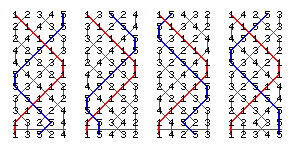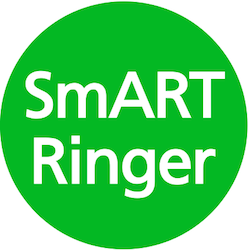Phil is a teacher at the Birmingham School of Bell Ringing and is passionate about getting the basics right for every new ringer, especially bell handling and ropesight. Here he shares some thoughts on moving onto Plain Bob Doubles.
Plain Bob Doubles has become the “go to” method for beginners to take their first steps in change ringing. This is what it looks like:

Plain Bob Doubles
However, if I were to suggest that you might instead prefer to start by learning this:

Bastow Little bob
you would most likely choose it because, for a start, it’s much shorter and, even when rung on just four bells (as shown here), it provides the basic building blocks of other methods you will encounter – hunting, dodging and place making – which you can then transfer when you’re ready to take on Plain Bob.
This method is called Bastow Little Bob Minimus, and the aim here is to learn the blue line (literally) and convert that into the ability to manœuvre a bell through this path of work. However, to make life a bit easier, what you see below is the same method but with the 2nd bell doing the work of the treble, and it looks like this:

Now you can ring the treble (which is now a working bell) and all the bells you will need to keep an eye on will be within a much narrower field of vision. I would suggest ringing on at least five bells, six preferably,and having the extra bells as cover bells. This will make the speed variation required much more manageable. No need to try and ring all 12 rows from the start, just see if you can get to the halfway point having done the 3-4 up dodge (whoever is in charge calls ‘stand’ at that point). Master this before then carrying on to do the 3-4 down dodge and hunting back to lead. When you can do this, try it again but pulling off in a different order, say 1,4,2,3 (with cover bells if you can). This will prevent you from simply learning the numbers and will gradually develop your ropesight. This is another important skill to acquire and like any skill, it takes time to master.
Ropesight is the ability to see which bell to follow without knowing beforehand. Once you get confident with the pattern of work you have to do and are comfortable with the speed variations, maybe pull off in the order 1,4,3,5,2,6 so that 2 and 6 are covering. This all adds to the fun whilst at the same time aiding ropesight development. From here, there are a few other methods you could try, sometimes without necessarily learning the blueline. You can find these methods on the SmART Ringer website under LtR Resources (seesmartringer.org/ltr/ltrres).
Bastow, for example, is one of the ‘stepping stone’ methods for Level 4. Another skill of ringing is the ability to transfer what you have learnt in one method to help you learn another, so after plenty of practice ringing Bastow, Plain Bob Minimus shouldn’t present too much of a problem if tackled next, and it looks like this:

Plain Bob Minimus
This has the same components as Bastow but with more plain hunting and seconds being made over the treble. To ring this you could learn the sequence of the work (3-4 up, 3-4 down, 2nds over the treble). Alternatively, you may be able to visualize the line in your head – some people can, others cannot – not everyone learns lines the same way. Alternatively, it can be rung by remembering a few simple rules such as:
•Having hunted to the back, if the treble is the last bell you pass, then lie and dodge;
•Having hunted to the back, if the treble is not the last bell you pass, then dodge and lie;
•If the treble turns you from lead, then make seconds and lead again.You may wonder how experienced ringers remember all the complicated methods they ring, and the answer is often by remembering a few simple rules such as the above and applying them to different situations.
Soif you can spend time acquiring these elementary skills you will find your change ringing career very rewarding.
This article by Phil Ramsbottom of the Birmingham School first appeared in the January 2020 edition of Tower Talk – ART’s free quarterly e-magazine for new ringers. If you would like to make sure you receive future editions, please sign up here

